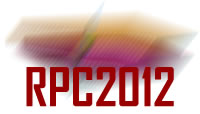Speaker
Mr
Huangshan Chen
(Tsinghua University)
Description
Data taken over the last several years have demonstrated that RHIC has created dense and rapidly thermalizing matter. One of the physics goals for the next decade of RHIC is to study the fundamental properties of hot, dense medium such as temperature, density profile, and color screening length via electro-magnetic probes such as di-leptons. Muons have a clear advantage over electrons due to reduced Bremsstrahlung radiation in the detector material. A novel and compact Muon Telescope Detector (MTD) in STAR at mid-rapidity will be constructed. A lot of R&D work of Long-strip Multi-gap Resistive Plate Chamber (LMRPC) has been done to fulfill the requirement of the STAR-MTD system. Last year, a new 6 250-micrometer gap LMRPC prototype with wide strip was built and tested in cosmic-ray and in beam. The module had 12 strips. Each strip was 3.8cm wide and 90cm long with 0.6 intervals. In cosmic-ray test, the efficiency was higher than 95% and the time resolution was around 75ps in the gas mixture of 94% Freon, 5% iso-Butane and 1%SF6. The efficiency was also higher than 95% and the time resolution was around 97ps in the gas mixture of 95% Freon and 5% iso-Butane. In the beam test, the efficiency was close to 100% and a time resolution of 55ps was got for the gas mixture of 90% Freon, 5% iso-Butane and 5%SF6. A good uniformity of the performance along the strip and across the strip was also shown during the test.
Another prototype with 5 gas-gaps was built in order to reduce the working high voltage of the STAR-MTD LMRPC module. This module was test in cosmic-ray. The efficiency was higher than 95% and the time resolution was around 95ps in the gas mixture of 95% Freon and 5% iso-Butane.
A new cosmic-ray test system with long scintillators was design in order to speed up the process of quality control. The first batch of 8 LMRPC modules has already been produced and sent to UT Austin. Every channel was test in cosmic-ray during the QC process. All the modules are qualified. That means the efficiency of each module is higher than 90%, the noise rate of each channel is less than 1Hz/cm2 and each module has less than 3 channels with a time resolution worse than 120ps in the working gas mixture of 95% Freon and 5% iso-Butane and under the working electric field of 100.8kV/cm.
Author
Mr
Huangshan Chen
(Tsinghua University)
Co-authors
Mr
Jingbo Wang
(Tsinghua University)
Mr
Xingming Fan
(Tsinghua University)
Prof.
Yi Wang
(Tsinghua University)

